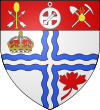 Global Information
Global InformationOttawa River timber trade information
| Part of a series on | ||||||||||||||||||||||||||||||||||||||||
| History of Ottawa | ||||||||||||||||||||||||||||||||||||||||
|---|---|---|---|---|---|---|---|---|---|---|---|---|---|---|---|---|---|---|---|---|---|---|---|---|---|---|---|---|---|---|---|---|---|---|---|---|---|---|---|---|
 | ||||||||||||||||||||||||||||||||||||||||
|
||||||||||||||||||||||||||||||||||||||||
| Timeline | ||||||||||||||||||||||||||||||||||||||||
|
||||||||||||||||||||||||||||||||||||||||
| Historical individuals | ||||||||||||||||||||||||||||||||||||||||
|
| ||||||||||||||||||||||||||||||||||||||||

The Ottawa River timber trade, also known as the Ottawa Valley timber trade or Ottawa River lumber trade, was the nineteenth century production of wood products by Canada on areas of the Ottawa River and the regions of the Ottawa Valley and western Quebec, destined for British and American markets. It was the major industry of the historical colonies of Upper Canada and Lower Canada and it created an entrepreneur known as a lumber baron. The trade in squared timber and later sawed lumber led to population growth and prosperity to communities in the Ottawa Valley, especially the city of Bytown (now Ottawa, the capital of Canada). The product was chiefly red and white pine.The Ottawa River being conveniently located with access via the St. Lawrence River, was a valuable region due to its great pine forests surpassing any others nearby.[1] The industry lasted until around 1900 as both markets and supplies decreased, it was then reoriented to the production of wood pulp which continued until the late 1990s and early 2000s.
The industry came about just before[2] Napoleon's 1806 Continental Blockade in Europe, forcing the United Kingdom to require a new source for timber, especially for its navy and shipbuilding. Later, Britain's application of gradually increasing protectionist tariffs on non-Empire goods increased Canadian imports. Leading into the early 1800s much of the pine in New Brunswick had been cut and Ottawa-Gatineau was considered the boundary for lumbering. Moving to the mid 1800s much of the pine in this once pristine area was now cut.[3] The first part of the industry, the trade in squared timber lasted until about the 1850s. The transportation for the raw timber was first by means of floating down the Ottawa River, first conducted in 1806 by Philemon Wright in Wright's Town.[4] Squared timber would be assembled into large rafts which held living quarters for men on their six-week journey to Quebec City, which had large exporting facilities and easy access to the Atlantic Ocean.[5]
The second part of the industry involved the trade of sawed lumber, and the New England lumber barons, and lasted chiefly from about 1850 to 1900–1910. The Reciprocity Treaty caused a shift to American markets. The source of timber in the UK changed, where its access to timber in the Baltic region was restored, and it no longer provided the protective tariffs. American entrepreneurs at that time then began to immigrate and build their operations near the Ottawa River, creating some of the world's largest sawmills. These lumber barons, such as John Rudolphus Booth, Henry Franklin Bronson, and Ezra Butler Eddy, founded mills and industries, alongside investing in public infrastructure and private residences, which were essential to the growth and development of early Ottawa. The sawed lumber industry benefited from transportation improvements, first the Rideau Canal[6] linking Ottawa with Kingston on Lake Ontario, and much later railways that began to be created between Canadian cities and northern U.S. markets.
Around 1906, the last raft was chuted down the Ottawa River. Squaring of timber to make rafts had become too wasteful and costly a solution to transportation, new hydro obstructions along the Ottawa and St. Lawrence Rivers had made it more difficult, and the growing road and rail networks, like the Canadian Atlantic Railway, founded by J.R. Booth in 1897 and spanning the region between Lake Huron, Ottawa, Montreal, and northern Vermont, had proven capable of supplying to the newer domestic and urban newspaper and magazine markets which had become the primary demand. Supplies of pine were dwindling and there was also a decreased demand for sawn timber. Many sawmills converted to pulp mills for the paper industry during this period. The UK was able to resume its supply from the Baltics, and their policies, especially the reduction in protectionism of their colonies, led to a decrease in markets in the UK. Shipbuilding turned towards steel, and the Atlantic fishing industry which provided domestic demand collapsed. Before 1950, many operations began to discontinue or be purchased by larger operations, and later many mills were completely removed and the spoiled land began to be restored in Urban Renewal policies in Ottawa. The industry had contributed greatly to population increases, culture, and economic growth of Ontario and Quebec.
- ^ http://ottawariver.org/pdf/09-ch2-7.pdf [bare URL PDF]
- ^ "The Timber Industry – VENI, VIDI, VICI! (I came, I sawed, I conquered!)". April 2024.
- ^ "Timber Trade History | The Canadian Encyclopedia". www.thecanadianencyclopedia.ca. Retrieved 2021-03-18.
- ^ Woods 1980, pp. 89.
- ^ "The Timber Industry – VENI, VIDI, VICI! (I came, I sawed, I conquered!)". 3 April 2020.
- ^ Legget 1986, pp. 96.